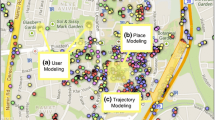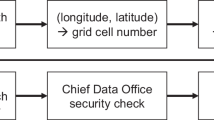Abstract
The ability to predict the arrival and residence time of mobile users at a particular place is essential for the development of a wealth of new applications and services, such as smart heating control, transportation planning or urban navigation. Previous techniques based on probabilistic models have not been able to perform such prediction accurately. In this paper, we present two linear mobility models, namely Linear Regression, and Auto-Regression, to predict the temporal behavior, particularly the residence time, of individual users. We run performance evaluation experiments on two different WiFi mobility traces datasets made available through the CRAWDAD project. Our results show that using linear regression-based learning algorithms significantly improve the residence time prediction accuracy compared to state-of-the-art methods, and achieve prediction errors in the order of seconds and minutes for a large number of users.






Similar content being viewed by others
References
Aalto, L., Göthlin, N., Korhonen, J., & Ojala, T. (2004). Bluetooth and wap push based location-aware mobile advertising system. In Proceedings of the 2nd international conference on Mobile systems, applications, and services (pp. 49–58). ACM.
Aschenbruck, N., Munjal, A., & Camp, T. (2011). Trace-based mobility modeling for multi-hop wireless networks. Computer Communications, 34(6), 704–714.
Baumann, P., Kleiminger, W., & Santini, S. (2013). How long are you staying?: Predicting residence time from human mobility traces. In Proceedings of the 19th annual international conference on Mobile computing & networking (pp. 231–234). ACM.
Bettstetter, C., Resta, G., & Santi, P. (2003). The node distribution of the random waypoint mobility model for wireless ad hoc networks. IEEE Transactions on Mobile Computing, 2(3), 257–269.
Burbey, I. (2011). Predicting future locations and arrival times of individuals. Ph.D. thesis, Virginia Tech.
Camp, T., Boleng, J., & Davies, V. (2002). A survey of mobility models for ad hoc network research. Wireless Communications and Mobile Computing, 2(5), 483–502.
Cho, E., Myers, S. A., & Leskovec, J. (2011). Friendship and mobility: User movement in location-based social networks. In Proceedings of the 17th ACM SIGKDD international conference on Knowledge discovery and data mining (pp. 1082–1090). ACM.
Chon, Y., Shin, H., Talipov, E., & Cha, H. (2012). Evaluating mobility models for temporal prediction with high-granularity mobility data. In 2012 IEEE international conference on pervasive computing and communications (PerCom) (pp. 206–212). IEEE.
Gonzalez, M. C., Hidalgo, C. A., & Barabasi, A.-L. (2008). Understanding individual human mobility patterns. Preprint arXiv:0806.1256.
Henderson, T., Kotz, D., & Abyzov, I. (2008). The changing usage of a mature campus-wide wireless network. Computer Networks, 52(14), 2690–2712.
Karamshuk, D., Boldrini, C., Conti, M., & Passarella, A. (2011). Human mobility models for opportunistic networks. IEEE Communications Magazine, 49(12), 157–165.
Kotz, D., & Essien, K. (2005). Analysis of a campus-wide wireless network. Wireless Networks, 11(1–2), 115–133.
Kotz, D., Henderson, T., Abyzov, I., & Yeo, J. (2009). CRAWDAD dataset dartmouth/campus (v. 2009-09-09). Downloaded from http://crawdad.org/dartmouth/campus/20090909.
Lenczner, M., & Hoen, A. G. (2015). CRAWDAD dataset ilesansfil/wifidog (v. 2015-11-06). Downloaded from https://crawdad.org/ilesansfil/wifidog/20151106.
Marmasse, N., & Schmandt, C. (2000). Location-aware information delivery withcommotion. In International symposium on handheld and ubiquitous computing (pp. 157–171). Springer.
Montoliu, R., Blom, J., & Gatica-Perez, D. (2013). Discovering places of interest in everyday life from smartphone data. Multimedia Tools and Applications, 62(1), 179–207.
Ng, A. Y. (2013). CS229: Machine learning lecture notes. Retrieved July 15, 2020 from http://cs229.stanford.edu/notes/cs229-notes1.pdf.
Noulas, A., Scellato, S., Lathia, N., & Mascolo, C. (2012a). Mining user mobility features for next place prediction in location-based services. In 2012 IEEE 12th international conference on data mining (ICDM) (pp. 1038–1043). IEEE.
Noulas, A., Scellato, S., Lathia, N., & Mascolo, C. (2012b). A random walk around the city: New venue recommendation in location-based social networks. In 2012 international conference on and 2012 international confernece on social computing (socialcom) privacy, security, risk and trust (PASSAT) (pp. 144–153). IEEE.
Pirozmand, P., Wu, G., Jedari, B., & Xia, F. (2014). Human mobility in opportunistic networks: Characteristics, models and prediction methods. Journal of Network and Computer Applications, 42, 45–58.
Ravi, L., & Vairavasundaram, S. (2016). A collaborative location based travel recommendation system through enhanced rating prediction for the group of users. Computational Intelligence and Neuroscience, 2016, 7.
Rodríguez Carrión, A. (2015). Contributions to the understanding of human mobility and its impact on the improvement of lightweight mobility prediction algorithms.
Rodriguez-Carrion, A., Garcia-Rubio, C., Campo, C., Cortés-Martín, A., Garcia-Lozano, E., & Noriega-Vivas, P. (2012). Study of lz-based location prediction and its application to transportation recommender systems. Sensors, 12(6), 7496–7517.
Sassi, A., Brahimi, M., Bechkit, W., & Bachir, A. (2019). Location embedding and deep convolutional neural networks for next location prediction. In 2019 IEEE 44th LCN symposium on emerging topics in networking (LCN symposium) (pp. 149–157). IEEE.
Sassi, A., Henouda, S. E., & Bachir, A. (2017). On predicting the residence time of mobile users at relevant places. In 2017 international symposium on networks, computers and communications (ISNCC) (pp. 1–6). IEEE.
Scellato, S., Musolesi, M., Mascolo, C., Latora, V., & Campbell, A. T. (2011). Nextplace: A spatio-temporal prediction framework for pervasive systems. In International conference on pervasive computing (pp. 152–169). Springer.
Scott, J., Bernheim Brush, A., Krumm, J., Meyers, B., Hazas, M., Hodges, S., & Villar, N. (2011). Preheat: Controlling home heating using occupancy prediction. In Proceedings of the 13th international conference on Ubiquitous computing (pp. 281–290). ACM.
Song, L., Deshpande, U., Kozat, U. C., Kotz, D., & Jain, R. (2006a). Predictability of wlan mobility and its effects on bandwidth provisioning. In 25TH IEEE international conference on computer communications proceedings IEEE INFOCOM 2006 (pp. 1–13).
Song, L., Kotz, D., Jain, R., & He, X. (2004). Evaluating location predictors with extensive wi-fi mobility data. In Twenty-third annualjoint conference of the IEEE computer and communications societies INFOCOM 2004 (vol. 2. pp. 1414–1424). IEEE.
Song, L., Kotz, D., Jain, R., & He, X. (2006b). Evaluating next-cell predictors with extensive wi-fi mobility data. IEEE Transactions on Mobile Computing, 5(12), 1633–1649.
Vu, L., Do, Q., & Nahrstedt, K. (2011). Jyotish: A novel framework for constructing predictive model of people movement from joint wifi/bluetooth trace. In 2011 IEEE international conference on pervasive computing and communications (PerCom) (pp. 54–62). IEEE.
Wu, R., Luo, G., Shao, J., Tian, L., & Peng, C. (2018). Location prediction on trajectory data: A review. Big Data Mining and Analytics, 1(2), 108–127.
Zheng, X., Han, J., & Sun, A. (2018). A survey of location prediction on twitter. IEEE Transactions on Knowledge and Data Engineering, 30(9), 1652–1671.
Author information
Authors and Affiliations
Corresponding author
Additional information
Publisher's Note
Springer Nature remains neutral with regard to jurisdictional claims in published maps and institutional affiliations.
Rights and permissions
About this article
Cite this article
Sassi, A., Bachir, A. & Bechkit, W. Evaluating Regression Models for Temporal Prediction of Wi-Fi Device Mobility. Wireless Pers Commun 116, 2169–2186 (2021). https://doi.org/10.1007/s11277-020-07785-2
Published:
Issue Date:
DOI: https://doi.org/10.1007/s11277-020-07785-2




